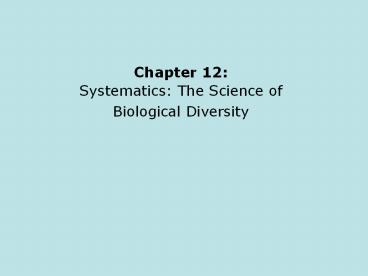Biology%20of%20Plants - PowerPoint PPT Presentation
Title:
Biology%20of%20Plants
Description:
Biology of Plants – PowerPoint PPT presentation
Number of Views:85
Avg rating:3.0/5.0
Title: Biology%20of%20Plants
1
Chapter 12 Systematics The Science of
Biological Diversity
2
(No Transcript)
3
(No Transcript)
4
(No Transcript)
5
(No Transcript)
6
Development of classification
- A. Until relatively recently organisms were
classified as either plants or animals and two
kingdoms were recognized. - 1. Non-motile autotrophs were placed in the plant
kingdom - 2. Motile heterotrophs were placed in the animal
kingdom
7
Many organisms didnt fit
- 1. Euglena is a unicellular, motile autotroph
- 2. Fungi (mushrooms and molds), traditionally
classified as plants, are non-motile heterotrophs
8
Technology led to better classifying cells
- 1. Prokaryotes (bacteria) - lack nuclei,
organelles, flagella, chromosomes,
multicellularity and sexuality - 2. Eukaryotes (nearly all other organisms) -
have nuclei, organelles, flagella, DNA
associated with histone proteins to form
chromatin/chromosomes, sexual reproduction and
most are multicellular
9
Thomas Whitaker (1969)
- 5 kingdom system
- All Prokaryotes were placed into a single
kingdom (Monera i.e. bacteria) and the Eukaryotes
were placed into four kingdoms Plantae, Fungi,
Animalia and Protista (unicellular)
10
Three domains
- A. Recent genetic and molecular investigations
have demonstrated that there are two major groups
of prokaryotes. They differ radically in the
composition of their cell walls, membrane lipids,
ribosomal RNA, and a variety of other biochemical
features
11
- Therefore, our text recognizes three domains
above the rank of kingdom
12
1. Domain Bacteria
- - prokaryotes with muramic acid in cell walls.
Majority of bacteria plus cyanobacteria ("blue
green algae")
13
2. Domain Archaea (ancient bacteria)
- - prokaryotes that lack muramic acid in cell
walls. Many inhabit "harsh" environments.
Includes methane producers, extreme halophiles,
extreme thermophiles, acidophiles and one group
which lacks cell walls
14
3. Domain Eukarya
- all eukaryotes, four kingdoms
- Animalia
- Plantae
- Fungi
- Protista
15
Kingdom Animalia (Animals)
- - motile, multicellular, lack plastids and cell
walls, heterotrophic via ingestion, sexual
reproduction
16
Kingdom Plantae (Plants)
- - nonmotile, multicellular, plastids and
autotrophic via photosynthesis, cell walls made
of cellulose, adapted for life on land, mostly
sexual reproduction. - "Algae" are not included in this kingdom
17
Kingdom Fungi (Mushrooms and Molds)
- - nonmotile, filamentous, lack plastids, cell
walls are made of chitin, heterotrophic via
absorption of nutrients from dead (saprophytic)
or living (parasitic) matter. Virtually all are
multicellular except yeast. Both sexual and
asexual reproduction
18
Kingdom Protista
- - lack multicellularity. Heterogeneous
assemblage of unicellular, colonial and
multicellular Eukaryotes that do not have the
distinctive characters of plants, animals or
fungi. - They have various types of reproduction from
simple cell division through sexual, and various
types of nutrition - Includes all groups previously called protozoa as
well as all the algae except blue greens. Also
includes some organisms previously called fungi
19
(No Transcript)
20
(No Transcript)
21
(No Transcript)
22
(No Transcript)
23
(No Transcript)
24
Origin of a Photosynthetic eukaryotic cell from a
heterotrophic prokaryote
25
(No Transcript)
26
(No Transcript)
27
(No Transcript)
28
(No Transcript)
29
(No Transcript)
30
(No Transcript)
31
(No Transcript)
32
Endosymbiosis in Vorticella
33
Autotrophic endosymbiotic alga
Electron Micrograph of a Vorticella
34
(No Transcript)
35
(No Transcript)
36
(No Transcript)
37
Fungi
- Lichen
- Fungus
- mushroom
38
Fungi- red blanket lichen Florida swamp
39
White coral fungus Clavariacea
40
Mushrooms genus Mycena Rainforest Peru
41
Earthball Scleroderma citrinum
42
Protist
- Plasmodium slime mold
- Postelsia palmiformis- sea palm
- Volvox- green alga
- Fauchea- red alga
- Pennate diatom
43
Plasmodium slime mold
44
Postelsia palmiformis- sea palm
45
Volvox- green alga
46
Fauchea- red alga
47
Pennate diatom
48
Plants
- Sphagnum (peat moss)
- Marchantia (thallose liverworts)
- Club moss
- Wood Horsetail
- Maidenhair fern
- Dandelion Taraxacum officinale
- Strawberry cactus
- Foxtail barley
- Cymbidium orchids
- Sugar pine
49
Sphagnum (peat moss)
50
Marchantia (thallose liverworts)
51
Club moss
52
Wood Horsetail
53
Maidenhair fern
54
Dandelion Taraxacum officinale
55
Strawberry cactus
56
Foxtail barley
57
Cymbidium orchids
58
Sugar pine
59
The principal types of Life cycles
- Zygotic meiosis
- Gametic meiosis
- Sporic meiosis
60
(No Transcript)
61
Give rise to gametes by differentiation
Divide by mitosis
4
62
4 haploid
Green/brown
63
Spores Dont act as gametes and Undergo Mitotic
division
produce
4 haploid
Differentiate to form Sporophyte































